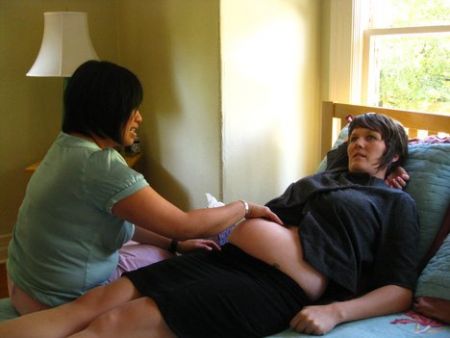According to a new number-crunching report by the Canadian Centre for Policy Alternatives, Halifax's forthcoming convention centre would be a $200 million “bottomless money pit.” The report points out that the centre would result in a loss of $29.5 million over 25 years, with the taxpayer cost being $404.5 million. Proponents of the centre hold up the money spent by the delegates while they're in town as an offset to the public money invested in the centre. The report did the math on that too, however, and came up with $180.80 million in combined provincial and federal tax revenue, for a total loss of $218.4 million. The spending by these international delegates is also wishful thinking, says the report, as most of the delegates, at least for the first ten years, will be local. (JL)
The last remaining midwife at the IWK hospital went on leave, leaving pregnant women scrambling to make last-minute birth arrangements. The Midwifery Coalition of Nova Scotia raised questions about the "attrition" of midwives at the clinic, where all four midwives hired to a "model" midwifery program have left since the province legalized and regulated the practice in early 2009. (BS)
Save Community Schools, a group fighting the proposed closure of three rural schools in Nova Scotia, demanded an external independent review of the Strait Regional School Board's (SRSB) conduct, pointing out that the Board presented the public with "misleading, inaccurate and incomplete information" about proposed closures. The SRSB, formed by appointments made by the Minister of Education in the late 1990s, implemented the controversial P-3 schools program, which axed nine rural schools before an elected board could be voted into power. (MP)
The Halifax Peace Coalition and the Nova Scotia Voice of Women for Peace asked Defence Minister Peter MacKay “to not be a Grinch and steal our future.” They held a peaceful vigil outside his constituency office in New Glasgow, demanding that MacKay cancel the $16 billion in taxpayer money he committed to F35 stealth fighters in July and end the war in Afghanistan, and invest instead in sustainable energy, child care, education and health care. (MP)
The Canadian Armed Forces opened a recruitment office in a strip mall on Mumford Road as part of a new model for offices across Canada, aimed to make enlisting in the army "more of a sales experience,” according to Commodore Daniel MacKeigan. (MP)
A transitional housing project on Gottingen St. for men coming out of homeless shelters faced opposition from some business owners in the area. "It's like taking a kid to a candy store, as far as I'm concerned. There's a crack house down the street," said the owner of the Company House bar. The project, a partnership between the Saint Leonard's Society and private developers, intends to provide affordable housing "indefinitely." (BS)
The report on the inquiry into the death of Wagmatcook fisherman John Simon was completed, but not released to the public. A redacted version was released to the Wagmatcook Band Council, who called the report an "exercise in result determinism," saying it is "replete with errors, omissions, and questionable inferences." John Simon, 44, was fatally shot by RCMP Constable Jeremy Frenette in December 2008 after barricading himself in his Wagmatcook home. Frenette had entered Simon's home against orders from his superior. The inquiry's report will be reviewed by RCMP top brass before being released to Simon's family. (MP)
Nova Scotia Power was granted a tax break on its wind farm projects just weeks after hitting ratepayers with a sixth rate hike in nine years. Emera, the private parent company of NS Power, posted record earnings in the third quarter of 2010. (BS)
Nature came out of nowhere and started whaling hard on the East Coast, with four major wind, rain and snow storms in as many weeks on one little region. A researcher with New Brunswick's Environment Department said the storms may be examples of climate change, and that we might want to pay more attention to how we develop because "nature will tend to win." (MP/BS)
The recent Africville Settlement, an agreement between HRM and the Africville Genealogy Society, was criticized by members of Halifax's Black community. The settlement, meant to restore Africville to its “rightful place in our community’s history” according to Halifax Mayor Peter Kelly, fell far short of expectations: most of the land that once comprised Halifax's Black community of Africville will remain a dog park, property of HRM, while another section of the former Africville sold to a private developer has been named Mont Blanc – after the ship at fault in the Halifax Explosion that destroyed Africville in 1917. (MP)
The Nova Scotia Rainbow Action Project (NSRAP) called on Halifax radio station Q104 to pull a station identification ad which the group said "reinforces negative attitudes toward 'gays'." The holiday ad said Q104 is “okay with decking the halls, but we draw the line at gay apparel.” The station claimed the ad was innocent humour, but then changed its ad, claiming it used the word 'gay' in a positive light. (MP)
The Waycobah First Nation in Cape Breton became the first community in Atlantic Canada to form an Elders' Council to advise its Band Council. Chief Morley Googoo emphasized that the move marks a retun to Mi'kmaq traditional government. "We decided to govern ourselves, the way we used to before The Indian Act was introduced to the Mi’kmaq nation," said the chief, noting that the Indian Act "did exactly what it was supposed to; it created divisions and instability." "We don’t need INAC’s [Indian and Northern affairs Canada] blessing," added the chief. (BS)
Six mink farmers in Digby county proposed that Nova Scotia build a $2-3 million anaerobic digester to turn mink waste and carcasses into energy. Mink farming is one of the fastest growing agricultural sectors in Nova Scotia, and the province produces nearly half of Canada's mink, with $80 million in export sales last year. Residents of Yarmouth and Digby have been pushing for a moratorium on new mink farms, as the farms have been shown to be a likely cause of excessive algae blooms – toxic to humans – and deteriorating water quality in those counties. (MP)




